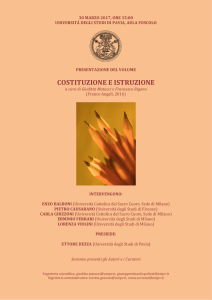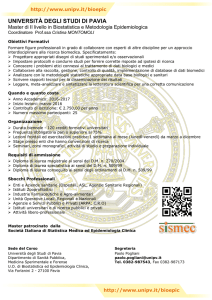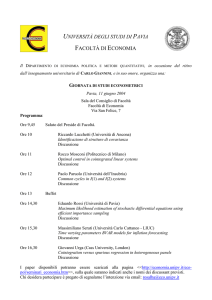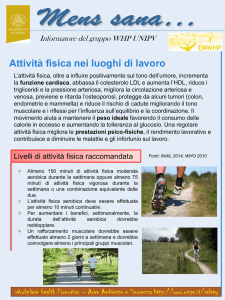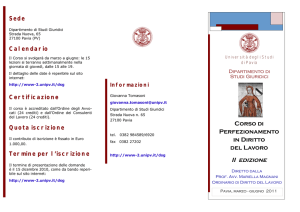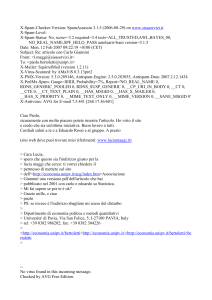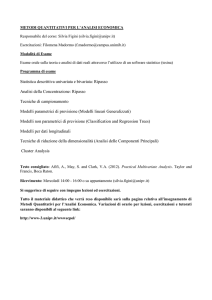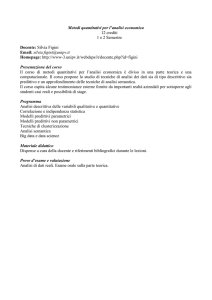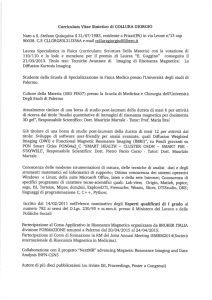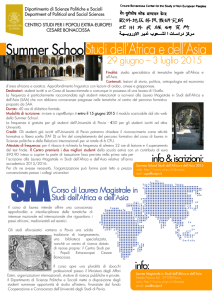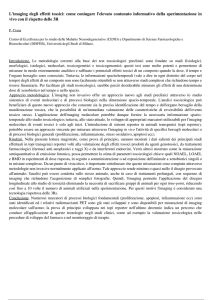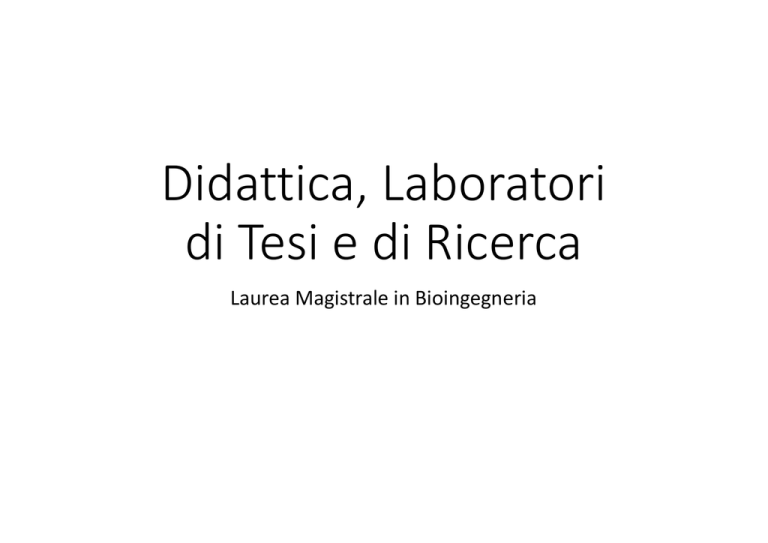
Didattica, Laboratori
di Tesi e di Ricerca
Laurea Magistrale in Bioingegneria
Strumentazione Biomedica LM
Prof. G. Beltrami
Ing. Matteo Bassi
2. Project
1. Think
3. Design
5. Test
4. Realize
Think, project, design, realize and test with Arduino and
Matlab your fully-compliant ECG acquisition board 2
What will we do? at a glance!
1. Electrical signals in the human body: how they generate
and how to model them!
3
What will we do? at a glance!
2. ECG: specs for our project
3. From the specs to the circuit: a step-by-step travel using
4
error-and-learn methodology to realize our design
What will we do? at a glance!
4. Layout of the circuit using OrCAD Layout
5. Physical realization of the PCB board in cleanroom
6. Soldering of the components
7. Testing with Matlab and Arduino!!
5
A picture of the analog board to
acquire ECG. This is the firstborn prototype!
6
The board is placed on Arduino, which
just works as a very simple ADC-to-USB
interface
7
MRI quantitativa: segnale, immagini,
modelli
Prof. Claudia AM Gandini
Direttore del Brain MRI 3T Mondino Research Center
Professor University College London
Ing. G. Castellazzi, PhD
Ing. A. De Rinaldis, Dr. F. Palesi
Principi di imaging quantitativo
Imaging quantitativo
Imaging strutturale
PSIR
Mappe della frazione di mielina
Le vie della sostanza bianca
Imaging della fisiologia
Perfusione
Spettroscopia
Contenuto di sodioImaging funzionale
NAA
Cr
Cr
Ch
o
Glu
Gl
n
GAB
A
Analisi quantitativa di immagini:
esempio imaging funzionale
Design matrix
(timing, HRF..)
fMRI time-series
Motion
Correction
Smoothing
Spatial
Normalisation
Statistical Parametric Map
General Linear Model
Parameter Estimates
Template
Slides modified from: www.fil.ion.ucl.ac.uk/spm/
Data mining con MRI
Big data
Data
Mining
Esempio applicazione clinica della
connettomica
Sani
12
Alzheimersa
Vascolari
Laboratory for Biomedical
Informatics
• Prof. Riccardo Bellazzi
• Prof. Silvana Quaglini
• Prof. Giordano Lanzola
• Prof. Cristiana Larizza
• Prof. Lucia Sacchi
Main Research Topics
• Clinical Data Mining and Data Analytics
•
•
•
Temporal Data Mining
Text Mining
Big Data ANalytics
• (Personalized) Decision Support Systems
•
•
•
Personalized Decision Support
Shared Decision Making
Cognitive Rehabilitation
• Telemedicine
•
•
Mobile Apps
Web Applications
The AP@home Project
• EU 7th Framework project
• Developing models and algorithms for delivering insulin
through an Artificial Pancreas
• Trials in 6 centers across Europe
SYNCHRO
MANUAL
INPUT
LOCAL
VIEWS
DATA
TYPES
PATIENT
DIARY
AUTOM.
INPUT
?
?
PLUGINS
File
File
File
DB
Architettura del Sistema
Paziente
DiAs
(Diabetes Assistance)
Roche
ACCU-CHEK
Combo
DEXG4
Servizio di
Telemedicina
Postazione
Remota
Eleonora Losiouk
[email protected]
CoRe: a software system for
computerized cognitive rehabilitation
REPOSITORY
USER INTERFACE
Stimuli ontology
Parameters setup
through user interface
Stimuli DB
Automatic adjustment
of difficulty
level
Performance
data storage
Patient
profiles DB
10 different exercise types:
Functional Planning
Image and Sound
Find the Intruder
Unscramble the Images
Unscramble the Sentence
Pick the Element
Find the Category
Logical Sequences
Logical Analogies
Word Coupling
E
x
e
r
c
i
s
e
S
t
a
r
t
Ambiti per il Telemonitoraggio
Condizioni
respiratorie
Stile di vita
Patologie
cardiache
Giordano Lanzola
Parametri
ematici
[email protected]
Attività fisica
Architettura del Sistema
Paziente
Smartphone
Bilancia
Sfigmomanometro
Servizio di
Telemedicina
•Report
•Allarmi
•SMS
Giordano Lanzola
[email protected]
Postazione
Remota
Il Progetto NeoKid
• Prematuri < 32 settimane
• Peso < 1.5 Kg
• 50 neonati
• 7 giorni
• NICU Ospedale – Università di Padova
• Miglioramento del controllo del tempo in range
Eleonora Losiouk
[email protected]
Henea Award @ SDA Bocconi
BIOMERIS
Spin-off
BIOMEdical Research Informatics Solutions
i2b2
Data-warehouse for integrating
clinical and research data
Biobank
i2b2 for integrating
biobank data
i2b2 extension for
Statistics and
Data-mining
i2b2 extension
for Very Large Scale
Database
Analytics Cell
BigQ NGS
TriNetX
Clinical Trial Design
and Recruitment
Laboratory of Bioinformatics,
Mathematical Modelling and
Synthetic Biology
Web site: http://lab-bioinfo.unipv.it
Lab Director: Prof. Paolo Magni
Contact: [email protected]
Areas
Bioinformatics
Mathematical modelling
Synthetic Biology
Bioinformatics
• Next Generation Sequencing (NGS)
• Implementation and validation of data analysis
pipelines for several sequencing applications;
• optimization of cluster and cloud environments;
• development of new algorithms and procedures for
NGS data analysis.
Velocity
•Need to be
analyzed quickly.
Volumes
Big Data problem
Variety
Ongoing collaborations
•Large amount of
data.
•Different types of
structured and
unstructured
data.
new spin-off of the University of Pavia, born to
provide bioinformatic solutions in NGS data anaysis
Bioinformatics
• Network-based pharmacology
• Network-based approaches to integrate
different data and knowledge sources;
• identification of combinations of hit targets to
act with pharmacological therapy.
Mathematical Modelling
Advanced expertise in
• Bayesian techniques (and Markov Chain Monte Carlo algorithms)
• Population analysis
• Deconvolution methods
PK/PD models
• Support of drug development and registration (in vitro, preclinical,
clinical studies)
• Development of PK-PD models to quantitatively describe kinetics,
mechanism of action and the effects on relevant endpoints of new
compounds currently under investigation
Research Areas
• Oncology: solid tumor, blood cancer, biomarkers, drug-drug interaction
• Biologicals: autoimmune diseases
• Study design: paediatrics, optimal design
Tools
• Matlab, R, NONMEM, Monolix, WinBUGS, Stan,
SimulX, PsN, Berkeley-Madonna
Sharing knowledge to improve drug development
Synthetic Biology (1/3)
De-novo synthesis of novel
organisms
Design of supplementary
functions in existing organisms
Bottom-up design in biological engineering:
Mathematical models
Datasheets
Predictable biological functions
Input
Output
System 1
System 2
Synthetic Biology (2/3)
• Typical workflow for the realization of novel artificial biological
functions:
Synthetic Biology (3/3)
• New research fields…
• Metabolic engineering
• CRISPR-dCAS9 gene regulation
Bioengineering Lab
Università degli
Studi di Pavia
Prof. Giovanni Magenes (coordinator)
Prof. A.Buizza, Prof. S. Ramat, Prof. L. Fassina
Dr. Giulia Matrone, PhD, Dr. F. Del Bianco, Dr. P. Colagiorgio
The main fields of expertise of the Bioengineering Lab group include:
• Advanced techniques for biosignals processing and analysis
• Soft-computing methods in biomedical applications
• Biomedical imaging and image processing
• Wearable sensors and systems
• Tissue engineering
Members:
Members:
4 Faculty Members
3 Post-doc fellows
5 PhD students
4/5 graduate students
The wearable system
Based on an Inner Garment, an Outer Garment and Boots,
integrating sensors and devices in order to monitor the user’s
health state and environmental variables
Electronic
Box
Flexible
Batteries
Washable
Sensors
Physiological,
Activity,
Environmental
Sensors
Gas Sensor
Boots
Results
HRnorm (physical stress)
HRnorm =
( HR − HRrest )
( HRmax − HRrest )
SMAnorm =
SMA
SMAmax
Bending on the legs
Running
Walking
Resting after mild activity
Resting after intense activity
SMAnorm (movement intensity)
Activities such as walking or bending on the legs (really different activities)
can’t be discriminated with the signal accelerometer, but they are easily
detected by using both the signals
Imaging ad ultrasuoni (1)
Sviluppo di sonde ecografiche basate su
trasduttori CMUT per neuronavigazione 3D
guidata da immagini MR (progetto europeo
ENIAC “DeNeCor”)
Z (c m )
• Simulazioni ed analisi di sistema per il design
dell’elettronica integrata nella sonda (in
collaborazione con STMicroelectronics)
• Tecniche di ricostruzione delle immagini
ultrasound e di registrazione delle immagini MR e US
• Studio di protocolli per l’acquisizione del set di
immagini 3D multimodali
5
5
0
4.5
4.5
-5
4
4
-10
3.5
3.5
-15
3
3
-20
2.5
2.5
-25
2
2
-30
1.5
1.5
-35
1
1
-40
0.5
0.5
0
-3
-2
-1
0
X (cm)
1
2
0
3 -3
-45
-2
-1
0
X (cm)
1
2
3
-50
MRI
Imaging ad ultrasuoni (2)
Sviluppo di nuove techniche di imaging
ad ultrasuoni (signal e image
processing)
•Algoritmi di ricostruzione delle immagini
•Tecniche per il miglioramento di
risoluzione e contrasto
•Tecniche per l’aumento del frame-rate
Imaging mm-wave
Sviluppo di un nuovo sistema di imaging
ad onde millimetriche per la detezione
del tumore al seno
• Metodi per la ricostruzione delle
immagini
antennas
Immagine della carotide
ottenuta con metodi standard
Immagine ad alta risoluzione e
contrasto ottenuta con un nuovo
algoritmo di ricostruzione
target
Primi test @UniPV: acquisizione dei dati e ricostruzione
dell’immagine
Tissue engineering and biomimetic approaches
Tissue Engineering Approach: development of a biomaterial, in vitro
culturing of cells (e.g. bone marrow stromal cells) within the biomaterial,
and implantation.
Seeding onto a biomaterial
Cell culture through a
bioreactor: physical
stimulation
Implant of a “self surface”
compatible with living
tissues
Cells
New experimental plan
Simulations
Numerical models
Bioreactors
Cells
Scaffolds
To overcome drawbacks associated with static culture systems (limited
diffusion, inhomogeneous cell-matrix distribution.
1) Bioreactors
2) Cells
• Types: Perfusion (P), Electromagnetic (E.M.F.), Ultrasound (US),
Vibrations
•
•
•
•
SAOS-2
human Bone Marrow Stromal Cells (hBMSC)
human Adipose Stem Cells (hADSC)
human Dental Pulp Stem Cells (hDPSCs)
Materials non biological but biocompatible
3) Scaffolds
• Polymers (slowly Biodegradable): Polyurethane porous; spongy
bone.
• Ceramics (Absorbable): Hydroxyapatite (HA); spongy bone.
• Metals (mechanical support, no degradable: Titanium Fiber Mesh
(T.F.M.); compact bone.
SISTEMI EMBEDDED E CALCOLO AD ALTE PRESTAZIONI IN BIOINGEGNERIA
Giovanni Danese - Francesco Leporati - Elisa Marenzi – Emanuele Torti
Strumentazione biomedicale embedded
40
30
20
10
0
−10
−20
−30
−40
−50
0
0.5
1
1.5
2
2.5
3
3.5
4
4.5
5
0
0.5
1
1.5
2
2.5
3
3.5
4
4.5
5
40
20
0
−20
−40
−60
−80
−100
FPGA technology
Estrazione real time fetal ECG
Innovate Italy Award
ARM technology
Lab on chip per analisi biomolecolari on site
Sistemi embedded per prevenzione ulcere pressione
Sistema
commerciale
Novel Pliance
Prototipo di laboratorio per il
monitoraggio pressione
Sistema di acquisizione DSP
GPU computing for Hyperspectral medicine
THE HUMAN BRAIN PROJECT
• Modelli matematici di cellule
neuronali ad alto realismo
• Supercalcolo
• Neurochips
THE HUMAN BRAIN PROJECT
NEUROCOMPUTERS
NEUROCHIPS
GPU
FPGA
Biomeccanica e Meccanica Computazionale
Prof. Ferdinando Auricchio ([email protected])
Prof. Alessandro Reali ([email protected])
Simone Morganti ([email protected])
Michele Conti ([email protected])
http://www.unipv.it/compmech/
http://www.unipv.it/compmech/thesis.html
http://www.youtube.com/user/CompMechPV?feature=watch
http://www-2.unipv.it/compmech/endstenting.html
http://www-2.unipv.it/compmech/aorticvalve.html
Nume-lab (structural)
Endovascular implants: from medical images to finite element analysis
Head-neck
Computed Tomography
Angiography (CTA)
2
1
3
Simulation result
Vascular model
4
3D reconstruction
(STL format)
Dicom images
(a series of planar slices)
Post-processing
6
5
Distal 2
Distal 1
Key collaboration:
IRCCS Policlinico San Donato (MI)
IRCCS Policlinico San Matteo (PV)
Ospedale Cisanello (PI)
Bifurcation 2
Bifurcation 1
Proximal2
Abaqus
Abaqus
Proximal1
http://www.unipv.it/compmech/proto-lab.html
Proto-lab
Objet 30 Pro
• Prototyping of anatomical models for surgical planning
• Surgical instrumentation prototypes
Leapfrog Creatr / 3ntr A4v2
• Testing of innovative filaments
• Mechanical characterization of 3d printed materials
• Available materials: ABS, PLA, PVA, Nylon, Polyurethane
Rubber
www.unipv.it/3d/
Key collaborations:
IRCCS Policlinico San Matteo (PV)
IRCCS Policlinico San Donato (MI)
Fluid-o-Tech
Filoalfa
http://www-2.unipv.it/compmech/activ-lab.html
SMA laboratory (Activ-lab)
Key collaboration:
Fondazione Maugeri (PV)
SMA actuators: properties and control
Devolpment of SMA-actuated devices
Experimental tests on SMA wires and
springs
Electrical properties of SMA tools and
self-sensing
+ Constitutive modeling
Mate-Lab
http://www-2.unipv.it/compmech/mate-lab.html
Key collaboration:
IRCCS Policlinico San Matteo (PV)
Experimental tests to mechanically characterize pathologic
human tissues and to calibrate constitutive models for
pathology evolution prediction
Beta-Lab
www.unipv.it/compmech/beta-lab.html
Pulse-duplicator
• Study of the cardiovascular fluiddynamics
• In-vitro simulation of
physiologic/pathologic conditions of the
aorta
Beta-lab activities
• In-vitro and ex-vivo modelling of
aortic dissection
• In-vitro study of aortic compliance
• Characterization of the systemic
resistance parameter of the circuit
Key collaborations:
• IRCCS Policlinico San Donato (Milan)
• UMCU Utrecht (NL)
Microstrutture tridimensionali in silicio:
Uno strumento innovativo per valutare
l’aggressività biologica di cellule tumorali
Prof. S. Merlo - Laboratorio Elettro-Ottica
Foto SEM di silicio 3D
IEEE TRANSACTIONS ON
NANOBIOSCIENCE, VOL. 14, NO. 7,
p. 797, OCTOBER 2015
High aggressiveness Low aggressiveness
Ovarian
Cancer cells
(b)
Breast Cancer cells
16 µm
16 μm
16 µm
16 μm
Un esempio di Tesi di Laurea Magistrale
Transilluminazione con radiazione infrarossa di tessuti
biologici: studio e realizzazione di un sistema portatile
per diagnostica biomedica Prof. S. Merlo - Laboratorio Elettro-Ottica
Battito cardiaco del
pulcino nell’uovo
Battito cardiaco
umano
Il portale della
Didattica KIRO
comunità Accademica online per la didattica
(Marzo
2014)
Come si
accede
Look & FEEL di
kiro
In sintesi
• Open Source – l.a.m.p.
• Moodle Based (Modular Object-Oriented Dynamic Learning
Environment)
• Virtual Server hosted (UNIPV WebFarm)
• Web Based
• Responsive Platforms
• Profiled system
• Cloud Oriented (next step)
• Distributed System
• LDAP Linked
• Fully supported (Cenralized / Distributed help Desks for
Teachers/Students/Employees)
In sintesi
gli studenti trovano in Kiro
• Learning Materials
•
•
•
•
•
•
•
•
•
•
Discussion forum
Classmates
Interactive tests
Young Assistants Support
exercises
External links
Feedback
Surveys
Videos
… (it depends by the teacher)
In sintesi
• Total Enrolled Teachers –
about 400
• Total Enrolled Students –
About 13.500
200 nuovi corsi
aperti da docenti
negli ultimi 6
mesi
In sintesi
200 corsi aperti ultimi 6
mesi per struttura
afferenza docenti
• Total Enrolled Teachers –
about 400
• Total Enrolled Students –
About 13.500
In Kiro anche
• 800 Video
didattici con
registrazione
delle lezioni in
aula per circa
200 CFU inerenti
6 CdS di Lauree
Magistrali
Centre for Health Technologies (CHT)
Maugeri
Hospital
Enigineering,
Mathematics &
Biotechnology
Neurological
Hospital
Volta and Nuovo
Colleges
Biochemistry,
Physiology
San Matteo
Hospital
Physics,Chemistry
& Pharmaceutics
63
Perché un Centro di Tecnologie per la Salute?
Il CHT sfrutta l’unicità del contesto pavese in Lombardia e la sua peculiarità nel panoramo italiano.
L’università di Pavia è l’unica università lombarda con dipartimenti e facoltà nelle aree di medicina,
biologia, farmacologia, ingegneria, scienze matematiche, fisiche e chimiche.
Inoltre a Pavia hanno sede tre centri di eccellenza di ricerca clinica (IRCCS), situati nelle immediate
vicinanze del campus universitario (nel raggio di un chilometro), che collaborano con I dipartimenti
universitari. Questo rende Pavia un ambiente “naturale” per promuovere la progettazione,
l’implementazione e la sperimentazione clinica di tecnologie innovative nel campo della salute, dai
biomateriali ai farmaci personalizzati, dalla bioinformatica alla biologia sintetica, dall’ingegneria dei tessuti
alla telemedicina.
64
Pillar 1 “Advanced Diagnostic Instrumentation”:
Instrumentation”: 4D Ultrasound Imaging
Objective: to develop a 3D ultrasound probe for micro-endoscopic MRI-guided neuronavigation, based on the emerging CMUT (Capacitive Micromachined Ultrasonic
Transducers) technology, miniaturization of the electronics and 3D packaging
Work in progress @DIII-UniPV in cooperation with STMicroelectronics
•
•
Development of the front-end electronics
to be integrated in the probe handle
System-level modeling and simulation
Development of image processing and 3D
reconstruction algorithms
Required expertise
• Micro-electronics
• Signal and image processing
• Bioengineering
Z (cm)
•
5
5
0
4.5
4.5
-5
4
4
-10
3.5
3.5
-15
3
3
-20
2.5
2.5
-25
2
2
-30
1.5
1.5
-35
1
1
-40
0.5
0.5
0
-3
-2
-1
0
X (cm)
1
Funded projects
• EU project ENIAC DeNeCoR «Devices for NeuroControl and NeuroRehabilitation»
2
0
3 -3
-45
-2
-1
0
X (cm)
1
2
3
-50
Pillar 1 “Advanced Diagnostic Instrumentation”:
Instrumentation”: Multimodal imaging
systems
Objective: to develop an advanced diagnostic imaging system which complementary
uses millimeter (mm)-waves and ultrasound for an improved tumor detection in
organs such as breast, skin or thyroid
Idea
• To develop a mm-wave ultra-wideband imaging system (up to 50 GHz)
for in vivo applications and to
investigate its feasibility
• To design a system able to
simultaneously acquire data from the
antenna array and ultrasound probe
• To implement both mm-wave and
ultrasound image reconstruction and
fusion algorithms
• To design and develop the integrated
electronics for signal
transmission/reception
X-ray
Microwaves
Ultrasound
Required expertise
• Mm-wave system and antenna design
• Signal and image processing
• Bioengineering
• Micro-electronics
• Radiology
Pillar 1 “Advanced Diagnostic Instrumentation”:
Instrumentation”: Multimodal imaging
systems
antennas
Work in progress @DIII-UniPV
• First laboratory tests to design the
mm-wave imaging system
• Characterization of the dielectric
properties of biological tissues up to
50 GHz (in cooperation with IEO)
• Study and development of algorithms
for mm-wave and ultrasound image
reconstruction
• Design of the integrated transceiver
electronics
Funded or under-review projects
• AIRC 2013 project, led by IEO
• EU Horizon2020 project – under review,
first-stage evaluation succesfully passed
• MIUR SIR project - under review
targets
US image
PC
US
probe
US system
Signal
pre-processing
Beamforming
algorithm
Envelope
detection
Mm-wave
image
VNA
Antenna
array
Rx signals
generation
Artifact
removal
Beamforming
algorithm
Envelope
detection
Pillar 2 - Big-data enabled infrastructures to support translational
research
Bedside to bench
Knowledge to practice
Knowledge discovery
Test new Knowledge
Pillar 2 – From Bedside to Bench
Anonymized data
Data
CRC
HIS
Match IDs i2b2
Researcher
Patient
Samples
Laboratory
Clinical patient
management
Anonymized samples
Biobank
Research
Pillar 2 – National and International Research projects
National and international
projects
ONCO-i2b2 project
BI OI NFORMATI CS METHODOLOGY AND TECHNOLOGY
TO I NTEGRATE
CLI NI CAL AND BI OLOGI CAL KNOWLEDGE
SUPPORTI NG
ONCOLOGY TRANSATI ONAL RESEARCH
Pillar 2 – New distributed decision support
Pillar 3 “Tissue
“ Tissue Engineering & Regenerative Medicine”: Hybrid Bone
Objective: to realize scaffolds seeded with human Stem Cells, cultured through bioreactors,
filled by human bone proteins and calcium minerals, usable in clinical application for bone
repair.
Work in progress @ CIT in cooperation with Lima, Gestlich, Striker: NEW SCAFFOLDS
TITANIUM (LIMA, Striker)
HYDROXYAPATITE
(GEISTLICH Biomaterials)
Pillar 3 “Tissue Engineering & Regenerative Medicine”: Hybrid Bone
USE OF E.M. FIELD
Static culture (40x)
E.M. culture (40x)
Cells sedeed on 8 PU scaffolds in
Mc Coy’s 5a medium
Frequency: 75 Hz Intensity: 1.8 Gauss
The electromagnetic stimulation increases the cell
proliferation and the synthesis of type-I collagen
(green fluorescence).
PETRI DISH
SOLENOIDS
Intensity of E.M. field on the Petri Disk
73
Pillar 3 “Tissue Engineering & Regenerative Medicine”: Cardiac Tissue
Engineering
Trajectory of marker # 1
Whole Heart / Cell Cultures
170
Cardiac Mechanics
165
y (pixel)
160
155
150
145
140
230
Drugs
Mechanical stimuli
Electromagnetic stimuli
240
250
x (pixel)
2D/3D mechanics
Physiological parameters
Models of diseases
260
270
Pillar 4 : Nanomedicine - objectives and fundings
ASI/ESA/NASA project:
NATO 2013-16
Under review ILRSA 2014
NM_4.
Nanoparticles
and microgravity
induced
osteoporosis.
NM_1. Multitasking
Nanoparticles (for
therapy and imaging).
NM_5. Biocharacterization.
MIUR-PRIN (2012-16)
BRE (2012-15)
Crowdfunding UNIPV ( 2015)
NM_2. Surfaceintelligent Medical
Devices.
Industrial companies
FIRB-Ideas (2009-15)
AIRC-IG (2013)
7th FRAMEWORK
PROGRAMME. Consolidator
Grant ( 2014-19)
NM_3. G-quadruplex
(G4) secondary nucleic
acid structures as
therapeutic targets.
MIUR-PRIN (2012-16)
Under review ricerca
finalizzata 2014
Pillar 4 : Nanomedicine - Applications in space
ISS
Bone (30-40 Yrs)
Osteoporosis
TEM nHAPs
30 Yrs on the
earth
Bone Remodeling
Osteoclasts
Osteoblasts
4-6 months of permanent stay on ISS
EU and Fluidic scheme
Hardware NATO:
• 12 + 2 Experiment Units (2 flight sets + 2 spare)
• 12 + 2 KIC-SL (2 flight sets + 2 spare)
Fragile bones

